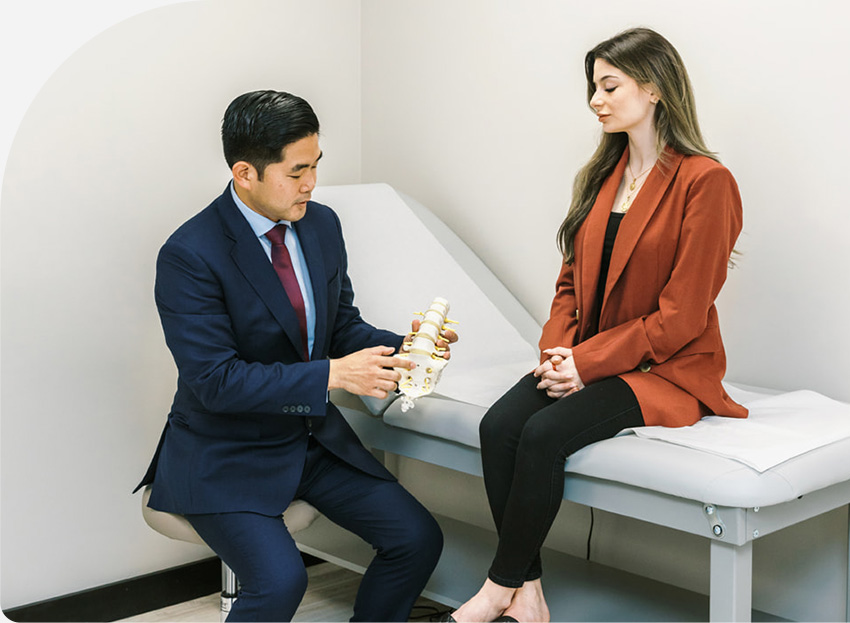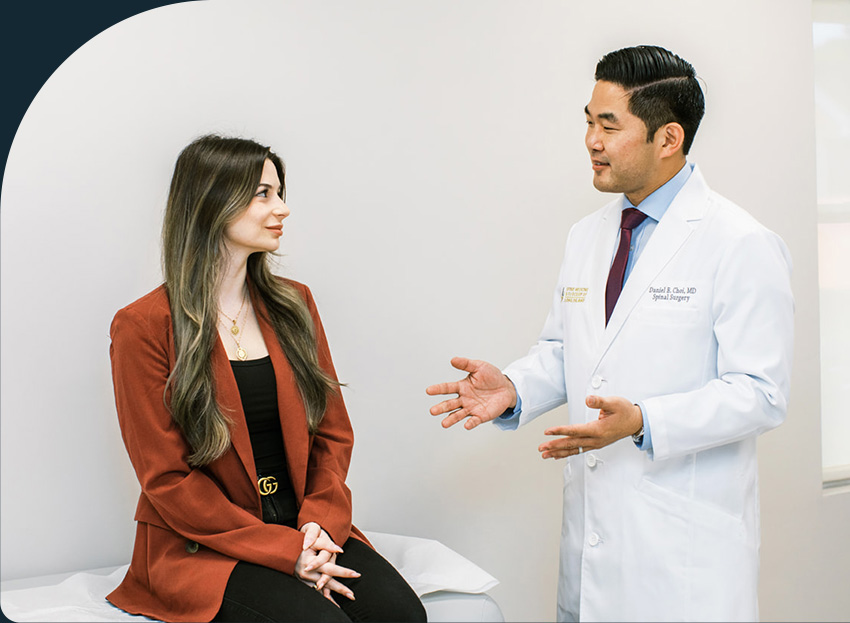Degenerative and herniated discs in the neck can lead to the compression of the spinal cord or nerve roots. When these structures are compressed, it often results in pain in the neck, shoulders, upper back and arm, as well as limited mobility, tingling, numbness and weakness.
ACDF, or anterior cervical discectomy and fusion, is a minimally invasive surgery performed to remove the degenerative or herniated disc and place a bone graft in the empty space. This decompresses the spinal cord and/or nerve roots, stabilizes the neck, relieves pain and other symptoms, and helps you return to your regular activities. To learn more or to find out if you’re a candidate for Long Island ACDF surgery, schedule a consultation with Dr. Daniel Choi today!
Benefits of ACDF
Provides Lasting Pain and Symptom Relief
Dr. Choi performs minimally invasive ACDF surgery, which results in less trauma, minimized scarring and a faster recovery period. The procedure can be effective even for those who have had neck pain for years.
Stabilizes the Neck
The procedure involves placing a bone graft where the disc was to stabilize the neck. As spinal fusion occurs, the painful movement that impacts mobility and function is eliminated.
Minimally Invasive and Effective
ACDF surgery removes the damaged disc, relieving the compression of the spinal cord or nerve roots, which gives patients lasting pain relief and also alleviates the neurological symptoms.
What Happens During ACDF Surgery?
Anterior cervical discectomy and fusion surgery is focused on the area between the seven cervical (neck) vertebral bodies (bones). When performing ACDF, Dr. Choi makes a small incision in the front of the neck while you’re under general anesthesia. He then gently moves the tissues and muscles aside before using tiny instruments to remove the ruptured or degenerated disc, which is known as discectomy.
Since the discs act as shock absorbers and keep the bones of the spinal column from rubbing against each other, Dr. Choi fills the gap left behind with a spacer bone graft. He secures the graft and the vertebrae with metal plates and screws. This is the fusion part of the procedure. The body’s natural healing response is stimulated and new bone grows around the graft and hardware, stabilizing the neck and serving as a cushion to prevent the bony vertebrae from collapsing.


The Types of Bone Grafts Used in ACDF
Dr. Choi will go over the pros and cons of the different types of bone grafts and help you decide on the best one for your needs. Options include:
When using autograft bone, Dr. Choi takes a small piece of bone from the iliac crest of your hip. This is done at the same time as your ACDF surgery. Autografts have a high rate of success because of the living, bone-growing cells and proteins they contain. However, you may have some discomfort while the area of your hip where the bone was harvested heals.
Allograft bone is organ donor bone that has been refined and sterilized. Since this bone doesn’t contain the living, bone-growing cells and proteins, Dr. Choi combines it with small shavings of living bone that he takes from your spine during surgery. The primary benefit of using allograft bone is that we don’t need to harvest bone from your hip, meaning there is no additional recovery time.
Substitute bone grafting material can be produced from ceramic, plastic or bioresorbable compounds that are specially designed for spinal fusion. When using a substitute bone grafting material, again, Dr. Choi will combine it with shavings of living bone that he takes from your spine during your procedure.
Artificial disc replacement is an alternative to bone grafting. Dr. Choi inserts the artificial disc into the area where your damaged disc was removed. This option offers stability without much of a loss in your existing range of motion.

ACDF Recovery
After your ACDF surgery, you’ll be moved to the recovery area so your vital signs can be monitored. Many patients can go home on the same day as surgery, however, this will depend on your individual case. Some post-operative pain should be expected, but it can be managed with medication.
You’ll also likely experience some range of motion loss after surgery. How much loss depends on the degree of neck mobility you had prior to surgery, as well as how many levels were fused together. With each fusion bridge, flexibility is decreased to some degree, which means the more fusions, the less range of motion.
The good news is, the pain relief most patients experience makes the slightly reduced range of motion well worth it. Additionally, certain exercises can improve your mobility. Do not begin these exercises until Dr. Choi gives you the go-ahead.
As we said, your body will naturally grow new bone around the graft and the vertebrae will fuse together into a continuous bone. This process can take between three and six months.

Am I a Candidate for ACDF?
Our Long Island spinal fusion surgeon, Dr. Choi, will evaluate your diagnostic records (i.e., x-rays, CT scans, MRI scans, etc.) and perform a thorough physical examination. He’ll also talk with you about your symptoms and the treatments you’ve tried in the past. This will allow him to determine if ACDF is the best solution for you.
The team at Spine Medicine & Surgery of Long Island takes a conservative approach, and surgery is typically reserved as a last option. Sometimes, depending on the severity of your case, nonsurgical treatments may help heal a bulging, or herniated, disc within a few months.
However, if conservative treatment fails and you’ve been suffering from chronic pain and symptoms related to extensive disc damage, surgery could be the ideal way to give you lasting relief. Dr. Choi will go over the risks and benefits of ACDF surgery with you to help you make an informed decision.
You may be a candidate if:
- Medical imaging tests show you have a degenerative or herniated disc
- You’ve been experiencing significant weakness in your hand or arm
- Your arm pain is worse than the pain in your neck

Less Pain, More Living
Find out how we can help you achieve freedom from pain. To get started, schedule a consultation with our Long Island spine surgeon today!



